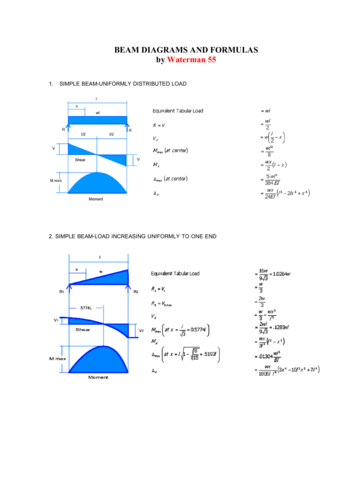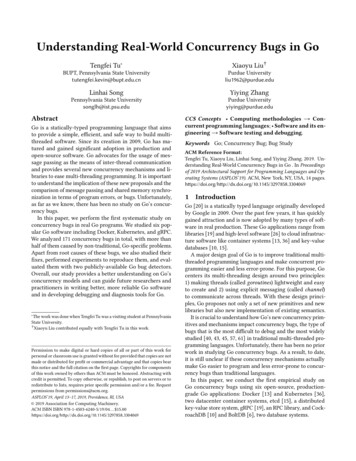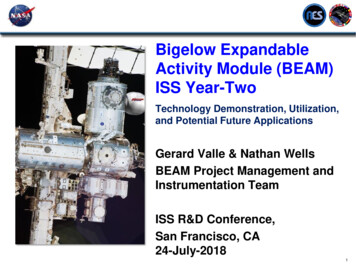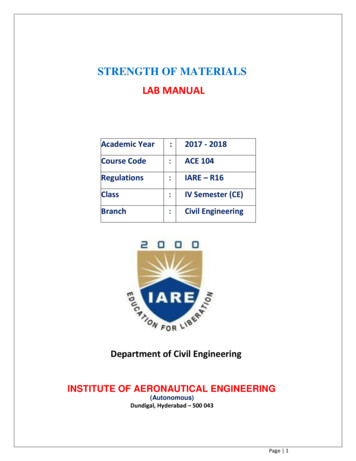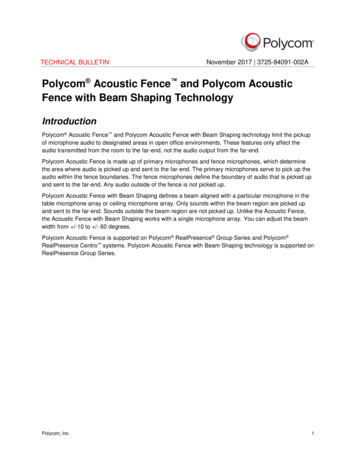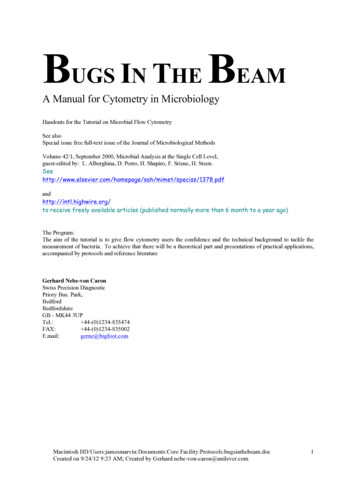
Transcription
BUGS IN THE BEAMA Manual for Cytometry in MicrobiologyHandouts for the Tutorial on Microbial Flow CytometrySee alsoSpecial issue free full-text issue of the Journal of Microbiological MethodsVolume 42/1, September 2000, Microbial Analysis at the Single Cell Level,guest-edited by: L. Alberghina, D. Porro, H. Shapiro, F. Srienc, H. t/speciss/1378.pdfandhttp://intl.highwire.org/to receive freely available articles (published normally more than 6 month to a year ago)The Program:The aim of the tutorial is to give flow cytometry users the confidence and the technical background to tackle themeasurement of bacteria. To achieve that there will be a theoretical part and presentations of practical applications,accompanied by protocols and reference literatureGerhard Nebe-von CaronSwiss Precision DiagnosticPriory Bus. Park,BedfordBedfordshireGB - MK44 3UPTel.: 44-(0)1234-835474FAX: 44-(0)1234-835002E.mail:gerne@bigfoot.comMacintosh HD:Users:jamesmarvin:Documents:Core Facility:Protocols:bugsinthebeam.docCreated on 9/24/12 9:23 AM; Created by Gerhard.nebe-von-caron@unilever.com1
1BACKGROUND INFORMATION1.11.21.32CYTOMETRY, BULK AND SINGLE CELL MEASUREMENTSFLOW CYTOMETRY AND SINGLE CELL SORTINGHISTORICAL BACKGROUNDTECHNICAL BACKGROUND2.1SETTING THE ENVIRONMENT :2.1.1Requirement on labware and reagents.2.1.2Preparation and handling of dye solutions2.1.3Sample Handling2.2SETTING UP THE INSTRUMENT : CALIBRATION STANDARDS, DISCRIMINATOR SETTINGS2.3SIGNAL PROCESSING: BACTERIAL DISCRIMINATION, BACK-GATING2.4LIGHT SCATTER MEASUREMENTS : OPPORTUNITIES AND LIMITATIONS2.5SORTING BACTERIA : INSTRUMENT PREPARATIONS AND SORTING3FUNCTIONAL AND DIFFERENTIAL LABELLING OF BACTERIA3.1BACTERIAL ENUMERATION: SAMPLE HANDLING, DISAGGREGATION AND COUNTING METHODS.3.1.1Counting methods3.1.2Sample disaggregation3.2THE VIABILITY CONCEPT3.2.1Reproductive growth3.2.2Metabolic activity measurements3.2.3Membrane integrity3.3ASSESSMENT OF STRESS AND INJURY BY THREE COLOUR MULTIPARAMETRIC ANALYSIS3.3.1Changes in membrane functionality in starvation and germination3.3.2The culture shock; recovery of injured Salmonella typhimurium3.4BACTERIAL DIFFERENTIATION: ANTIBODY STAINING OF ‘ENVIRONMENTAL’ SAMPLES.3.4.1Classical differentiation methods3.4.2Differentiation by nucleic acid probes3.4.3Identification by immunological methodsBIBLIOGRAPHY4MICROBIAL FLOW CYTOMETRY IN BIOTECHNOLOGY (SUSANN MÜLLER)4.1YEASTS4.1.1Analysis of 3ß-hydroxysterols4.1.2Analysis of DNA4.1.3Analysis of neutral lipids with nile red4.2BACTERIA4.2.1Methylotrophic gram-negative bacteria4.2.2Determination of the membrane potential in gram-negative strains4.2.3Application of strain specific rRNA probesto gram-negative bacteria2Macintosh HD:Users:jamesmarvin:Documents:Core Facility:Protocols:bugsinthebeam.docCreated on 9/24/12 9:23 AM; Created by 353
1 Background InformationThe direct microscopical observation of “animalcules” by Leeuwenhoek in 1674 as described in hisletters to the British Royal Society has been one of the key events of science of the last few centuries. It facilitatedthe understanding of the single cell nature of bacteria. The fact that one of these small organisms can give rise to anentire culture or colony has given microbiologists a single cell analysis system of outstanding detection sensitivitywithout the need for high tech equipment. The high amplification factor from 1 cell to 1010 cells and more, and thesimple visual detection gave rise to a variety of microbiological tests based on cell growth.The improvement in microscopic analysis of stressed and injured cells or the observations in extremeenvironmental conditions, in particular in connection with fluorescent probes, have highlighted the discrepanciesbetween bacterial existence and their replication. The experience of replication in the form of raising children cangive a ‘macroscopic’ insight in the stress and lifestyle changes caused by such process. To avoid similar distortionscaused by post sampling growth, it appears that observations into natural microbial populations have to be based ondirect optical detection methods on the single cell level.1.1Cytometry, bulk and single cell measurementsBecause of the importance of microbiology to human health, methods have been developed to enumeratebacteria to identify them and to look at the impact of physical, chemical of biological interventions. Bulkmeasurements like changes in turbidity, conductivity or gas pressure of liquid media (Figure 1) have become popularfor bacterial detection because of their ease of handling, their detection speed. Selective growth media can allowsome degree of bacterial differentiation, but detailed differentiation is still achieved by cell isolation followed byeither biochemical, immunological or genetic characterisation. Whilst immunological and genetic differentiation canalso be applied directly to certain samples, preenrichment steps are usually applied to generate sufficient signal.Figure 1:Cytometry as bulk or single cell measurementsBulk measurements are usually easy to perform and less expensive. In most cases cellgrowth is required to generate enough signal. Direct single cell measurements on the other hand tendto be more complex. They do not require post sampling growth and can reflect the true heterogeneityof microbial populations.The cornerstone of microbiology has been single cell analysis. Colonies derived from single cells havebeen examined by the plating techniques developed by Koch more than a century ago. The strength of thistechnique, the high amplification factor of 109-12 is also its weakness, the dependence on growth. In the times ofPasteur and Koch as well as nowadays, this growth limitation can only be overcome by direct single cellmeasurements like image or flow cytometric methods, which also allow assessment of the true amount of sampleheterogeneity. The power of the combination of image analysis and microscopy was already appreciated by Koch,who took pictures of his microscopic images. The spatial resolution of the microscope not only allows thecharacterisation of cell morphology, but also the position of bacteria within a sample matrix. This can giveinformation about its development of biofilms or potential symbiotic interactions. Unfortunately the high amount ofdata processing in computerised image analysis limits the sample throughput and the analysis of high cell numbers,which are better achieved by the measurement of cell suspensions by flow cytometry (FCM). Spatial resolution ofFCM is more macroscopic, related to the site of sampling. Only recently, hybrids between both technologies havebecome available in the form of laser scanning cytometers and, perhaps in the long run, the restriction of imageanalysis to data processing of critical data only may lead us back to the microscopical beginning.Macintosh HD:Users:jamesmarvin:Documents:Core Facility:Protocols:bugsinthebeam.docCreated on 9/24/12 9:23 AM; Created by Gerhard.nebe-von-caron@unilever.com3
1.2Flow cytometry and single cell sortingIn a flow cytometer cells, or other particulate matter, flow through a zone of investigation whereparameters of interest are measured. The history of bacterial flow cytometry probably starts with the work ofTyndall in the mid 19th century. He detected the absence of particles in the air of his dust free box by means of lightscattering in a light beam as illustrated in microbiology text books (e.g. Pelczar, Jr. et al. 1993). And nearly 200years after the onset of cytometry by Leeuwenhoek, it was Robert Koch’s manual cell sorting which led to theisolation of Bacillus anthracis, proving the link between a disease and a certain bacterium.In modern flow cytometers the measurement is taken electronically. The classic example of FCM is theCoulter Counter, where cells are suspended in a particle free solution and a fixed volume is passed through a narroworifice. Depending on their size, the particles change the electric current running across the orifice, generatingsignals which give rise to accurate enumeration and particle sizing. In the context of this study flow cytometry isrestricted to instruments based on optical measurements. The major elements of such a modern multi parameter flowcytometer are shown in Figure 2. Typically, light scatter and fluorescence signals are measured to provide a varietyof information on, for example, surface-structure, membrane permeability, pH, or DNA/RNA content. The fluidicsystem is designed to guide the cells in single file through the centre of a focused laser beam (hydrodynamicfocusing). The amount of light scattered or emitted by each particle is measured, digitalized and fed into a computer.There the different optical signals are correlated and groups or clusters of cells are identified and statisticallyanalysed as shown in Figure 3.Certain instruments allow the user not only to analyse these cell populations but also sort them forpreparative purposes. From all the sorting principles (Lindmo et al. 1990) the droplet-based sorters have become themost widespread systems. In those sorters the flow chamber vibrates vertically at a high frequency and the outcoming liquid stream is disrupted into small uniform droplets. At a fixed time after the cell is measured it reaches thelast droplet attached to the liquid stream. If the cell falls in a cluster of interest, it is then selected for sorting and theliquid stream is charged positively or negatively for the time of droplet separation. Depending on the charge, thedroplet is deflected in an electric field into collection vessels for subsequent analysis.The strength of flow cytometry lies in its capacity for single cell measurements, its acquisition speed andits numerical power. The total illumination of the particle in the laser beam allows the quantification of thefluorescence intensity per particle. By looking at multiple parameters of a thousand cells per second, groups orclusters can be identified. Screening several thousand cells also allows the detection of low frequency events with astatistical significance. Correct total enumeration of aerobic, anaerobic and facultative anaerobic bacteria in mixedpopulations becomes possible, as the method does not depend on post sampling growth.The most detailed descriptions of flow cytometric systems, including how to build your own, can befound in “Practical Flow Cytometry” by Howard Shapiro (Shapiro, 1995). It also represents the most comprehensivesource about staining techniques which can be applied. Flow Cytometry and Sorting (Anonymous1990a) also givesdetailed technical background on flow cytometry and there are other extensive manuals such as “Current Protocols”,“Flow Cytometry” as part of “Methods in Cell Biology” (Anonymous1994) that cover various aspects of thetechnology. The handbooks of Longobardi-Givian (Longobardi-Givian, 1992), Ormerod (Anonymous1990b) andparticularly the manual published by the Royal Microscopical Society (Ormerod, 1994) might serve as a more easyto read literature for beginners that focus on the essential concepts.4Macintosh HD:Users:jamesmarvin:Documents:Core Facility:Protocols:bugsinthebeam.docCreated on 9/24/12 9:23 AM; Created by Gerhard.nebe-von-caron@unilever.com
Figure 2:Detection system of a generalised “five parameter” laser based flowcytometerA sheath flow is running through a flow cell forming a laminar liquid stream. Into this streama particle or cell suspension is injected to be guided into a sensing zone in single file, one after theother. Whenever a cell or particle goes through the intercept with the illuminating laser beam, light isscattered. Photons of the same wavelength as the incoming light are collected axial andperpendicular to the light beam (forward angle and right angle light scatter). Fluorescent signals arealso collected perpendicular to the light beam and separated onto different detectors using mirrors andfilters with appropriate spectral characteristics. The photomultiplier tubes (PMT’s) convert the lightintensity into electric signals that are fed into a computer. Cell sorting is achieved by verticallyvibrating the flow cell at several thousand hertz to generate uniform droplets. If an event fulfils thedesired scatter and fluorescent properties, the whole liquid system is charged with a high voltagewhen this cell has reached the point of droplet breakoff. Depending on the given charge, the dropletcontaining that cell can therefore be deflected in an electric field and deposited in tubes, on slides oragar plates.Macintosh HD:Users:jamesmarvin:Documents:Core Facility:Protocols:bugsinthebeam.docCreated on 9/24/12 9:23 AM; Created by Gerhard.nebe-von-caron@unilever.com5
Figure 3:Data analysis of a two parameter or bivariate dot plotThe figure shows a typical analysis screen of the Coulter Version II software. The display isa correlation of orange versus green fluorescence on the projection of the single channel histograms.Increasing dot density represents increasing number of particles with similar measurement values,thus clustering. Whilst the single parameter histograms projected to the sides already indicate two orthree populations contained in the sample, the true heterogeneity only becomes apparent whencorrelating separate parameters. The clusters are then analysed by regions of interest for relative andabsolute counts and signal intensity as shown at the bottom of the screen.1.3Historical backgroundThe history of cytometry of single microbes goes back to the discovery of the ‘animalcules’ byLeeuwenhoek with his microscope who made drawings to characterise their morphology, followed by Koch whoalready used photography to document his microscopic observations down to modern image analysis systems. Flowcytometry probably started with the ‘dust free box’ of Tyndall in the late 19th century. He observed the lightscattering of aerosols in the path of a light beam in order to determine the stage at which he could expose broth to theair without becoming contaminated. Driven by the need to identify bacterial aerosols in warfare, the next generationof flow cytometers started a mere 100 ears later, with a similar design in the late 1940's (Gucker et al. 1947; Ferry etal. 1949; Gucker and O'Konski, 1949). The next period of more intensive flow cytometry in microbiology started inthe mid 1970's by Hutter (Hutter, 1974; Hutter et al. 1975a; Hutter et al. 1975b); Paau et al (1977); Slater et al (1977)and Bailey et al (1977). Hutter and Eipel (1978) were the first to undertake a complex study on viability, totalprotein and cell cycle of bacteria, yeast and moulds and the auto-fluorescence of algae. They already utilised thepower of multiparameter measurements possible with FCM, a feature neglected in most of the more recent studies.In 1980 Hutter also started to apply the technique to look at bacterial growth inhibition (Hutter and Oldiges, 1980).At the same time Steen used a modified microscope which he developed into a flow cytometer more geared formicrobial applications (Steen and Lindmo, 1979; Steen and Boye, 1980; Steen, 1983). He did fundamental work in6Macintosh HD:Users:jamesmarvin:Documents:Core Facility:Protocols:bugsinthebeam.docCreated on 9/24/12 9:23 AM; Created by Gerhard.nebe-von-caron@unilever.com
bacterial replication and subsequently drug susceptibility (Steen et al. 1982; Steen et al. 1986) and also appliedimmunofluorescence (Steen et al. 1982). Further work in flow cytometric differentiation by antibody staining wasdone by Ingram et al (Ingram et al. 1982), Sahar et al (Sahar et al. 1983), Phillips and Martin (Phillips and Martin,1983; Phillips and Martin, 1985), Barnett et al (Barnett et al. 1984) and Libertin et al (Libertin et al. 1984). Since theeighties, the number of articles applying FCM in microbiology seems to follow exponential growth.Successful cell sorting of bacteria was probably first described by Paau et al (Paau et al. 1979) whoseparated algae from bacteria. Other early papers were Cohen et al (Cohen et al. 1982), Libertin et al (Libertin et al.1984) and the technique has been exploited extensively in the industry for strain improvement (Betz et al. 1984).Libertin et al were the first to use sorting in combination with immunofluorescence for the detection of Pneumocystiscarinii for microscopical confirmation of the organism, a principle revisited nearly ten years later for the analysis ofCryptosporidium (Vesey et al. 1993).Flow cytometry has become one of the key techniques in analytical cytology of mammalian cells. Thesuccess of the technique for example in the field of clinical immunology is based on three main factors:0. the big separation between differentiated clusters that allows easy data interpretation1. the functional significance of these clusters2. the positive attitude of medical scientists towards technologyThe application of the technique in microbiology clearly represents a challenge as compared tomammalian cells, bacteria are only 1/10 of the diameter, thus cell surface is only 1/100 and cell volume 1/1000which has clearly implications on the signals derived from them. The acceptance of the technology is growing aswell in the field of microbiology. This is partially due to the improvements in the technology, leading to data andcluster separation that start to become convincing even to non flow cytometrists. To gain even more acceptance, it isnecessary to resolve some of the conflicting data with regards to the applicability of fluorescent labelling and toverify functional significance of clusters as determined by flow cytometry by means of sorting.References:Bailey, J.E., Fazel-Madjlessi, J., McQuitty, D.N., Lee, Y.N., Allred, J.C. and Oro, J.A. (1977) Characterization of bacterialgrowth by means of flow microfluorometry. Science 198, 1175-1176.Barnett, J.M., Cuchens, M.A. and Buchanan, W. (1984) Automated immunofluorescent speciation of oral bacteria using flowcytometry. J. Dent. Res. 63, 1040-1042.Betz, J.W., Aretz, W. and Härtel, W. (1984) Use of flow cytometry in industrial microbiology for strain improvementprograms. Cytometry 5, 145-150.Cohen, J., Perfect, J.R. and Durack, D.T. (1982) Method for the purification of Filobasidiella neoformans basidiospores byflow cytometry. Sabouraudia. 20, 245-249.Ferry, R.M., Farr, R.M., Jr. and Hartman, M.G. (1949) The preparation and measurement of the concentratoins of dilutebacterial aerosols. Chem. Rev. 44, 389-417.Gucker, F.T., O'Konski, C.T., Pickard, H.B. and Pitts, J.N. (1947) A photoelectronic counter for coloidal particles. J. Am.Chem. Soc. 69, 2422-2431.Gucker, F.T. and O'Konski, C.T. (1949) Electronic methods for counting aerosol particles. Chem. Rev. 44, 373-388.Hutter, K.J. (1974) Untersuchungen über die DNS-, RNS- und Proteinsynthese von Hefezellen der Gattung Sacharomycesmit Hilfe neuer fluorometrischer Methoden. 19/FB13, Berlin.Hutter, K.J., Boose, H., Oldiges, H. and Emeis, C. (1975a) Investigations about the synthesis of DNA, RNA and proteins ofselected populations of microorganisms by Cytophotometry and Pulse-Cytophotometry. 3. Determination of intracellularsubstancesof partially synchronized aerobe and respiratory deficient yeast cells. (Untersuchungen über die DNS-, RNS- undProteinsynthese ausgewählter Mikroorganismenpopulationen mit Hilfe der Zytophotometrie und der Impulscytophotometrie.3. Mitteilung: Bestimmung der Zellinhaltsstoffe teilsynchronierter atmungsfähiger und atmungsdefecter Hefezellen.).Chem,Mikrobiol. Technol. Lebensm 4, 101-104.Hutter, K.J., Göhde, W. and Emeis, C. (1975b) Investigations about the synthesis of DNA, RNA and proteins of selectedpopulations of microorganisms by Cytophotometry and Pulse-Cytophotometry. 1.Methodical investigations about appropriatefluorescence dyes and staining procedures. (Untersuchungen über die DNS-, RNS- und Proteinsynthese ausgewählterMacintosh HD:Users:jamesmarvin:Documents:Core Facility:Protocols:bugsinthebeam.docCreated on 9/24/12 9:23 AM; Created by Gerhard.nebe-von-caron@unilever.com7
Mikroorganismenpopulationen mit Hilfe der Zytophotometrie und der Impulscytophotometrie. 1. Mitteilung: MethodischeUntersuchungen über geeignete Färbeverfahren.). Chem,Mikrobiol. Technol. Lebensm 4, 29-32.Hutter, K.J. and Eipel, H.E. (1978) Flow cytometric determinations of cellular substances in algae, bacteria, moulds andyeasts. Antonie van Leeuwenhoek 44, 269-282.Hutter, K.J. and Oldiges, H. (1980) Alterations of proliferating microorganisms by flow cytometric measurements after heavymetal intoxication. Ecotoxicol. Environ. Saf. 4, 57-76.Ingram, M., Cleary, T.J., Price, B.J., Price, R.L. and Castro, A. (1982) Rapid detection of Legionella pneumophila by flowcytometry. Cytometry 3, 134-137.Libertin, C.R., Woloschak, G.E., Wilson, W.R. and Smith, T.F. (1984) Analysis of Pneumocystis carinii cysts with afluorescence- activated cell sorter. J. Clin. Microbiol. 20, 877-880.Paau, A.S., Cowles, J.R. and Oro, J. (1977) Flow-microfluorometric analysis of Escherichia coli, Rhizobium meliloti, andRhizobium japonicum at different stages of the growth cycle. Canadian Journal Of Microbiology 23, 1165-1169.Paau, A.S., Cowles, J.R., Oro, J., Bartel, A. and Hungerford, E. (1979) Separation of algal mixtures and bacterial mixtureswith flow-microfluorometer using chlorophyll and ethidium bromide fluorescence. Archives Of Microbiology 120, 271-273.Phillips, A.P. and Martin, K.L. (1983) Immunofluorescence analysis of bacillus spores and vegetative cells by flowcytometry. Cytometry 4, 123-131.Phillips, A.P. and Martin, K.L. (1985) Dual-parameter scatter-flow immunofluorescence analysis of Bacillus spores.Cytometry 6, 124-129.Sahar, E., Lamed, R. and Ofek, I. (1983) Rapid identification of Streptococcus pyogenes by flow cytometry. Eur. J. Clin.Microbiol. 2, 192-195.Slater, M.L., Sharrow, S.O. and Gart, J.J. (1977) Cell cycle of Saccharomycescerevisiae in populations growing at differentrates. Proc. Natl. Acad. Sci. U. S. A. 74, 3850-3854.Steen, H.B., Boye, E., SKARSTAD, K., Bloom, B., Godal, T. and Mustafa, S. (1982) Applications of flow cytometry onbacteria: cell cycle kinetics, drug effects, and quantitation of antibody binding. Cytometry 2, 249-257.Steen, H.B. (1983) A microscope-based flow cytophotometer. Histochem. J. 15, 147-160.Steen, H.B., SKARSTAD, K. and Boye, E. (1986) Flow cytometry of bacteria: cell cycle kinetics and effects of antibiotics.Ann. N. Y. Acad. Sci. 468, 329-338.Steen, H.B. and Boye, E. (1980) Bacterial growth studied by flow cytometry. Cytometry 1, 32-36.Steen, H.B. and Lindmo, T. (1979) Flow cytometry: a high-resolution instrument for everyone. Science 204, 403-404.Vesey, G., Slade, J.S., Byrne, M., Shepherd, K., Dennis, P.J. and Fricker, C.R. (1993) Routine monitoring ofCryptosporidium oocysts in water using flow cytometry. J. Appl. Bacteriol. 75, 87-90.8Macintosh HD:Users:jamesmarvin:Documents:Core Facility:Protocols:bugsinthebeam.docCreated on 9/24/12 9:23 AM; Created by Gerhard.nebe-von-caron@unilever.com
2 Technical background2.1Setting the environment :2.1.1 Requirement on labware and reagents.Measuring bacteria means detecting submicron particles. Therefore it is essential to ensure that allreagents are not only sterile but also particle free. That means that all solutions have to be passed through at least0.45 µm or better 0.2 µm filters.Labware should also be dust and particle free. The major problem of washed glassware is theaccumulation of paper fibres from autoclave tape, usually not removed prior to washing. Therefore sterile filtrationshould be performed into disposable labware if possible. Safety considerations in particular with regards to thehandling of infectious and potentially carcinogenic material also suggest the use of plastics.The reagents used should be analytical research grade (AnalaR) where possible. Buffer solutions andliquid media should regularly be checked for pH and osmolarity as a form of basic quality control in particular afteraddition of ingredients (like for example EDTA).2.1.2 Preparation and handling of dye solutionsWith respect to health and safety regulations, at least the DNA fluorochromes have to be treated asmutagenic. With the risk posed by the other dyes with unknown toxicological properties and the solvents used, itshould be common practice to treat all dye solutions as potentially carcinogenic. Thus it is important to wear gloves,labcoat and if required protective eye-wear. Dry components should be handled in a draft free environment to avoidthe formation of dust. Work areas should be wiped generously with alcoholic solutions like 75% isopropanol priorand after handling the dyes. Sterile filtration of dye solutions should be performed by centrifugation through filtermembranes like for example 0.2 mm Anapore Micro-Centrifuge tube filters (Whatman, Maidstone, UK) to avoid therisk of spluttering.Disposal of stained samples has to be done by incineration to achieve destruction of the potentialcarcinogens. Autoclaving does not destroy the compounds and sample liquids would pose a risk to servicepersonnel. The waste liquid from the cytometer should be treated with sodium hypochlorite ( 2500 ppm) over nightand neutralised with Sodium thiosulfate before disposal.If possible, the use of solvents should be avoided. They can change the membrane permeability to thedyes and other molecules and can either distort the measurements or even be cytotoxic. They can also sometimespenetrate laboratory gloves and increase the risk of dye handling.Please note that the concentrations below are guiding figures and should always be optimised for the testconditions. There can be numerous components in growth media can severely reduce the amount of freely availablefluorochromes. Apart from Molecular Probes, dyes can be sourced from Lambda Fluorescence Technology,Polysciences and Eastman-Kodak.Table 1Commonly used dye solutions: commercial sources, solvents and concentrations.BOXBis-Oxonol or bis-(1,3-dibutylbarbituric acid)trimethine oxonol (DiBAC4(3))[Molecular Probes, Eugene, OR, USA, # B-438] (FW 516.64)Stock solution :10.0 mg/ml in DMSO, -20 CWorking solution : 10 or 100.0 µg/ml in A.D., 0.5% Tween, 4 CFinal concentration :0.1-1.0 µg/ml(Oxonols may require addition of a base to be soluble.)EBEthidium Bromide[Sigma, Poole, UK; # E8751] (FW 394.3)Stock solution :10.0 mg/ml in A.D., -20 CWorking solution :500.0 µg/ml in A.D., 4 CFinal concentration :5-10.0 µg/mlMacintosh HD:Users:jamesmarvin:Documents:Core Facility:Protocols:bugsinthebeam.docCreated on 9/24/12 9:23 AM; Created by Gerhard.nebe-von-caron@unilever.com9
PIRH123CFACCFASBac LightViability KitPropidium Iodide[Sigma, Poole, UK, # P4170] (FW 668.4)Stock solution :2.0 mg/ml in A.D., 4 CWorking solution :500.0 µg/ml in A.D., 4 CFinal concentration :5-10.0 µg/mlRhodamine 123[Lambda Fluoresce Technologie, Graz, Austria, # LP-250] (FW 380.8)Stock solution :10.0 mM in DMSO, -20 CWorking solution :0.1 mM in A.D., 4 CFinal concentration :0.2-1.0 µMCarboxy-Fluorescein-diAcetate[Lambda Fluoresce Technologie, Graz, Austria, # LA-551] (FW 460.4)Stock solution :10.0 mM in DMSO, -20 CWorking solution :100.0 µM in A.D., 4 CFinal concentration :20-50.0 µMdiChloro-CFA-Succinimidylester[Lambda Fluoresce Technologie, Graz, Austria, # LA-574] (FW 626.37)Stock solution :10.0 mM in DMSO, -20 CWorking solution :100.0 µM in A.D., 4 CFinal concentration :20-50.0 µMproprietary mixture of fluorochromes[Molecular Probes, Eugene, OR, USA, #2.1.3 Sample HandlingApart from the chemical hazard already mentioned, bacterial samples bare a biological risk. The two keysteps in the sample handling process were bacteria can become airborne are the mechanical sample disaggregationand the measurement in the cell sorter. Thus in the case of sample sonication it is important to use lids on tubes orvessels and to ensure that sonicator probes are sufficiently submerged into the liquid. Single cell sorting requires theformation of small droplets to be deflected in an electric field. The sort chamber of the EPICS Elite already forms abiohazard containment incorporating a screen protection for the operator and the application of a slight underpressure to the sort chamber, sucking air through a biohazard filter. ‘Mist’ formation occurs either when the sortcrystal is out of tune or the sort stream hits a horizontal surface. Both can be prevented by careful alignment of thesystem prior to the measurement of samples and is required for successful sorting anyhow.Whilst all lab solutions require filtration to reduce background signals, samples also require filtration toprotect flow instrumentation from becoming clogged. As any 77 µm particle is bound to block the 76 µm sort nozzleit is recommended to pre-filter in particular environmental samples through a 50 µm nylon filter mesh. Whilst it ispossible to obtain such material in bulk sheets (Züricher Beuteltuchfabrik, Rüschlikorn, Switzerland) ready to usedevices are nowadays available as sterile disposable units from a number of companies (Dako, High Wycombe, UK;Partec, Münster, Germany). In addition the sample inlet of sorters should also be fitted with a piece of filter mesh.As this can increase the risk of sample carryover it is advisable to run a sterile filtered detergent containing ‘washsample’ between samples.2.2Setting up the instrument : Calibration standards, Discriminator settingsThe initial and daily instrument alignment should be made with a three or more bead mixture of smallfluorescent (yellow/green) and nonfluorescent latex beads around 300nm, 600nm and 1000nm. The smaller theparticles the lesser they follow the hydrodynamic focusing. Usually optimal alignment requires volume flow ratesettings close to flow cut off.Select a display of log side scatter (y-axis) versus log green fluorescence (x-axis). As most instrumentsha
found in "Practical Flow Cytometry" by Howard Shapiro (Shapiro, 1995). It also represents the most comprehensive source about staining techniques which can be applied. Flow Cytometry and Sorting (Anonymous1990a) also gives detailed technical background on flow cytometry and there are other extensive manuals such as "Current Protocols",


